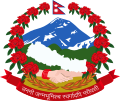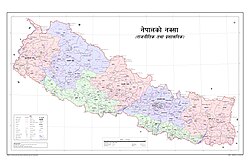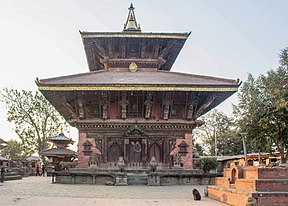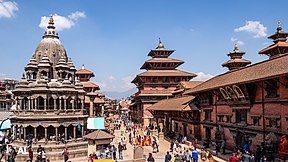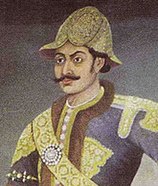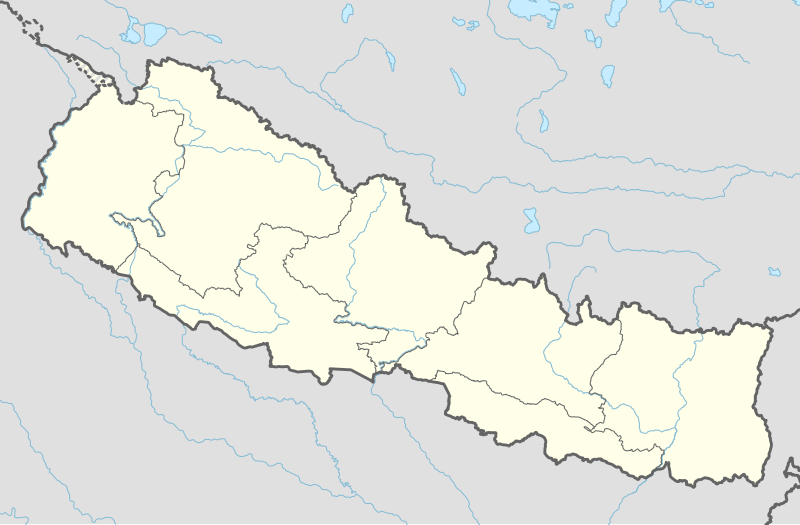
A | B | C | D | E | F | G | H | CH | I | J | K | L | M | N | O | P | Q | R | S | T | U | V | W | X | Y | Z | 0 | 1 | 2 | 3 | 4 | 5 | 6 | 7 | 8 | 9
Federal Democratic Republic of Nepal | |
|---|---|
| Motto: जननी जन्मभूमिश्च स्वर्गादपि गरीयसी (Sanskrit) Janani Janmabhumishcha Swargadapi Gariyasi "Mother and Motherland are Greater Than Heaven" | |
| Anthem: सयौँ थुँगा फूलका (Nepali) Sayaun Thunga Phulka "Made of Hundreds of Flowers" | |
Location of Nepal in dark green; territory claimed but controlled by India shown in light green | |
| Capital and largest city | Kathmandu[1] 28°10′N 84°15′E / 28.167°N 84.250°E |
| Official languages | Nepali[2] |
| Recognised national languages | All mother-tongues[3][4] (see Languages of Nepal) |
| Ethnic groups (2021)[5] | |
| Religion (2021)[6] | |
| Demonym(s) | |
| Government | Federal parliamentary republic |
| Ram Chandra Poudel | |
| Ram Sahaya Yadav | |
| Pushpa Kamal Dahal | |
| Bishowambhar Prasad Shrestha | |
| Legislature | Federal Parliament |
| National Assembly | |
| House of Representatives | |
| Formation | |
| 25 September 1768[7] | |
| 4 March 1816 | |
| 21 December 1923 | |
| 28 May 2008 | |
| 20 September 2015 | |
| Area | |
• Total | 147,516 km2 (56,956 sq mi) (93rd) |
• Water (%) | 2.8% |
| Population | |
• 2022 estimate | 30,666,598[10] (49th) |
• Density | 180/km2 (466.2/sq mi) (72nd) |
| GDP (PPP) | 2023 estimate |
• Total | |
• Per capita | |
| GDP (nominal) | 2023 estimate |
• Total | |
• Per capita | |
| Gini (2010) | 32.8[12] medium |
| HDI (2019) | medium (142nd) |
| Currency | Nepalese rupee (Rs, रू) (NPR) |
| Time zone | UTC+05:45 (Nepal Standard Time) |
| Date format | YYYY/MM/DD |
| Driving side | left |
| Calling code | +977 |
| ISO 3166 code | NP |
| Internet TLD | .np |
Nepal,[a] officially the Federal Democratic Republic of Nepal,[b] is a landlocked country in South Asia. It is mainly situated in the Himalayas, but also includes parts of the Indo-Gangetic Plain. It borders the Tibet Autonomous Region of China to the north, and India to the south, east, and west, while it is narrowly separated from Bangladesh by the Siliguri Corridor, and from Bhutan by the Indian state of Sikkim. Nepal has a diverse geography, including fertile plains, subalpine forested hills, and eight of the world's ten tallest mountains, including Mount Everest, the highest point on Earth. Kathmandu is the nation's capital and the largest city. Nepal is a multi-ethnic, multi-lingual, multi-religious and multi-cultural state, with Nepali as the official language.
The name "Nepal" is first recorded in texts from the Vedic period of the Indian subcontinent, the era in ancient Nepal when Hinduism was founded, the predominant religion of the country. In the middle of the first millennium BC, Gautama Buddha, the founder of Buddhism, was born in Lumbini in southern Nepal. Parts of northern Nepal were intertwined with the culture of Tibet. The centrally located Kathmandu Valley is intertwined with the culture of Indo-Aryans, and was the seat of the prosperous Newar confederacy known as Nepal Mandala. The Himalayan branch of the ancient Silk Road was dominated by the valley's traders. The cosmopolitan region developed distinct traditional art and architecture. By the 18th century, the Gorkha Kingdom achieved the unification of Nepal. The Shah dynasty established the Kingdom of Nepal and later formed an alliance with the British Empire, under its Rana dynasty of premiers. The country was never colonised but served as a buffer state between Imperial China and British India. Parliamentary democracy was introduced in 1951 but was twice suspended by Nepalese monarchs, in 1960 and 2005. The Nepalese Civil War in the 1990s and early 2000s resulted in the establishment of a secular republic in 2008, ending the world's last Hindu monarchy.
The Constitution of Nepal, adopted in 2015, affirms the country as a secular federal parliamentary republic divided into seven provinces. Nepal was admitted to the United Nations in 1955, and friendship treaties were signed with India in 1950 and China in 1960. Nepal hosts the permanent secretariat of the South Asian Association for Regional Cooperation (SAARC), of which it is a founding member. Nepal is also a member of the Non-Aligned Movement and the Bay of Bengal Initiative. The Nepalese Armed Forces are the fifth-largest in South Asia; and are notable for their Gurkha history, particularly during the world wars, and has been a significant contributor to United Nations peacekeeping operations.
Etymology

Before the unification of Nepal, the Kathmandu Valley was known as Nepal.[c] The precise origin of the term Nepāl is uncertain. Nepal appears in ancient Indian literary texts dated as far back as the fourth century BC.[which?] An absolute chronology can not be established, as even the oldest texts may contain anonymous contributions dating as late as the early modern period. Academic attempts to provide a plausible theory are hindered by the lack of a complete picture of history and insufficient understanding of linguistics or relevant Indo-European and Tibeto-Burman languages.[17]
According to Hindu mythology, Nepal derives its name from an ancient Hindu sage called Ne, referred to variously as Ne Muni or Nemi. According to Pashupati Purāna, as a place protected by Ne, the country in the heart of the Himalayas came to be known as Nepāl.[18][19][d] According to Nepāl Mahātmya,[e] Nemi was charged with protection of the country by Pashupati.[20] According to Buddhist mythology, Manjushri Bodhisattva drained a primordial lake of serpents to create the Nepal valley and proclaimed that Adi-Buddha Ne would take care of the community that would settle it. As the cherished of Ne, the valley would be called Nepāl.[21] According to Gopalarājvamshāvali, the genealogy of ancient Gopala dynasty compiled c. 1380s, Nepal is named after Nepa the cowherd, the founder of the Nepali scion of the Abhiras. In this account, the cow that issued milk to the spot, at which Nepa discovered the Jyotirlinga of Pashupatināth upon investigation, was also named Ne.[17]
Norwegian indologist Christian Lassen had proposed that Nepāla was a compound of Nipa (foot of a mountain) and -ala (short suffix for alaya meaning abode), and so Nepāla meant "abode at the foot of the mountain". He considered Ne Muni to be a fabrication.[22] Indologist Sylvain Levi found Lassen's theory untenable but had no theories of his own, only suggesting that either Newara is a vulgarism of sanskritic Nepala, or Nepala is Sanskritisation of the local ethnic;[23] his view has found some support though it does not answer the question of etymology.[24][25][26][17] It has also been proposed that Nepa is a Tibeto-Burman stem consisting of Ne (cattle) and Pa (keeper), reflecting the fact that early inhabitants of the valley were Gopalas (cowherds) and Mahispalas (buffalo-herds).[17] Suniti Kumar Chatterji believed Nepal originated from Tibeto-Burman roots – Ne, of uncertain meaning (as multiple possibilities exist), and pala or bal, whose meaning is lost entirely.[27]
History
Ancient Nepal
By 55,000 years ago, the first modern humans had arrived on the Indian subcontinent from Africa, where they had earlier evolved.[28][29][30] The earliest known modern human remains in South Asia date to about 30,000 years ago.[31] The oldest discovered archaeological evidence of human settlements in Nepal dates to around the same time.[32]
After 6500 BC, evidence for the domestication of food crops and animals, construction of permanent structures, and storage of agricultural surplus appeared in Mehrgarh and other sites in what is now Balochistan.[33] These gradually developed into the Indus Valley civilisation,[34][33] the first urban culture in South Asia.[35] Prehistoric sites of palaeolithic, mesolithic and neolithic origins have been discovered in the Siwalik hills of Dang district.[36] The earliest inhabitants of modern Nepal and adjoining areas are believed to be people from the Indus Valley civilisation. It is possible that the Dravidian people whose history predates the onset of the Bronze Age in the Indian subcontinent (around 6300 BC) inhabited the area before the arrival of other ethnic groups like the Tibeto-Burmans and Indo-Aryans from across the border.[37] By 4000 BC, the Tibeto-Burmese people had reached Nepal either directly across the Himalayas from Tibet or via Myanmar and north-east India or both.[38] Stella Kramrisch (1964) mentions a substratum of a race of pre-Dravidians and Dravidians, who were in Nepal even before the Newars, who formed the majority of the ancient inhabitants of the valley of Kathmandu.[39]
By the late Vedic period, Nepal was being mentioned in various Hindu texts, such as the late Vedic Atharvaveda Pariśiṣṭa and in the post-Vedic Atharvashirsha Upanishad.[40] The Gopal Bansa was the oldest dynasty to be mentioned in various texts as the earliest rulers of the central Himalayan kingdom known by the name 'Nepal'.[41] The Gopalas were followed by Kiratas who ruled for over 16 centuries by some accounts.[42] According to the Mahabharata, the then Kirata king went to take part in the Battle of Kurukshetra. In the south-eastern region, Janakpurdham was the capital of the prosperous kingdom of Videha or Mithila, that extended down to the Ganges, and home to King Janaka and his daughter, Sita.
Around 600 BC, small kingdoms and confederations of clans arose in the southern regions of Nepal. From one of these, the Shakya polity, arose a prince who later renounced his status to lead an ascetic life, founded Buddhism, and came to be known as Gautama Buddha (traditionally dated 563–483 BC).[43] Nepal came to be established as a land of spirituality and refuge in the intervening centuries, played an important role in transmitting Buddhism to East Asia via Tibet,[44] and helped preserve Hindu and Buddhist manuscripts.
By 250 BC, the southern regions had come under the influence of the Maurya Empire. Emperor Ashoka made a pilgrimage to Lumbini and erected a pillar at Buddha's birthplace, the inscriptions on which mark the starting point for properly recorded history of Nepal.[45] Ashoka also visited the Kathmandu valley and built monuments commemorating Gautama Buddha's visit there. By the 4th century AD, much of Nepal was under the influence of the Gupta Empire.[f][46]
In the Kathmandu valley, the Kiratas were pushed eastward by the Licchavis, and the Licchavi dynasty came into power c. 400 AD. The Lichchhavis built monuments and left a series of inscriptions; Nepal's history of the period is pieced together almost entirely from them.[47][44] In 641, Songtsen Gampo of the Tibetan Empire sends Narendradeva back to Licchavi with an army and subjugates Nepal. Parts of Nepal and Licchavi was later under the direct influences of the Tibetan empire.[48] The Licchavi dynasty went into decline in the late 8th century and was followed by a Thakuri rule. Thakuri kings ruled over the country up to the middle of the 11th century AD; not much is known of this period that is often called the dark period.[49]
Medieval Nepal
In the 11th century, a powerful empire of Khas people emerged in western Nepal whose territory at its highest peak included much of western Nepal as well as parts of western Tibet and Uttarakhand of India. By the 14th century, the empire had splintered into loosely associated Baise rajyas, literally 22 states as they were counted. The rich culture and language of the Khas people spread throughout Nepal and as far as Indo-China in the intervening centuries; their language, later renamed the Nepali language, became the lingua franca of Nepal as well as much of North-east India.[44]
In south-eastern Nepal, Simraungarh annexed Mithila around 1100 AD, and the unified Tirhut stood as a powerful kingdom for more than 200 years,[50] even ruling over Kathmandu for a time.[51] After another 300 years of Muslim rule, Tirhut came under the control of the Sens of Makawanpur.[50] In the eastern hills, a confederation of Kirat principalities ruled the area between Kathmandu and Bengal.
In the Kathmandu valley, the Mallas, who make several appearances in Nepalese history since ancient times, had established themselves in Kathmandu and Patan by the middle of the 14th century. The Mallas ruled the valley first under the suzerainty of Tirhut but established independent reign by late 14th century as Tirhut went into decline. In the late 14th century, Jayasthiti Malla introduced widespread socio-economic reforms, principal of which was the caste system. By dividing the indigenous non-Aryan Buddhist population into castes modelled after the four Varna system of Hinduism, he provided an influential model for the Sanskritisation and Hinduisation of the indigenous non-Hindu tribal populations in all principalities throughout Nepal. By the middle of the 15th century, Kathmandu had become a powerful empire which, according to Kirkpatrick, extended from Digarchi or Sigatse in Tibet to Tirhut and Gaya in India.[52] In the late 15th century, Malla princes divided their kingdom in four – Kathmandu, Patan and Bhaktapur in the valley and Banepa to the east. The competition for prestige among these brotherly kingdoms saw the flourishing of art and architecture in central Nepal, and the building of famous Kathmandu, Patan and Bhaktapur Durbar Squares; their division and mistrust led to their fall in the late 18th century, and ultimately, the unification of Nepal into a modern state.[44][53]
Apart from one destructive sacking of Kathmandu valley in the mid 14th century,[54] Nepal remains largely untouched by the Muslim invasion of India that began in the 11th century. The Mughal period saw an influx of high-caste Hindus from India into Nepal. They soon intermingled with the Khas people and by the 16th century, there were about 50 Rajput-ruled principalities in Nepal, including the 22 (Baisi) states and, to their east in west-central Nepal, 24 Chaubisi states. There emerged a view that Nepal remained the true bastion of unadulterated Hinduism at a time when Indian culture had been influenced by centuries of Mughal, followed by British rule. Gorkha, one of the Baisi states, emerged as an influential and ambitious kingdom with a reputation for justice, after it codified the first Hinduism-based laws in the Nepalese hills.[44]
Unification, expansion and consolidation (1768–1951)
In the mid-18th century, Prithvi Narayan Shah, a Gorkha king, set out to put together what would become present-day Nepal. He embarked on his mission by securing the neutrality of the bordering mountain kingdoms. After several bloody battles and sieges, notably the Battle of Kirtipur, he managed to conquer the Kathmandu Valley in 1769.[55] The Gorkha control reached its height when the Kumaon and Garhwal Kingdoms in the west to Sikkim in the east came under Nepalese control. A dispute with Tibet over the control of mountain passes and inner Tingri valleys of Tibet prompted the Qing Emperor of China to start the Sino-Nepali War compelling the Nepali to retreat to their own borders in the north.[56] The rivalry between the Kingdom of Nepal and the East India Company over the control of states bordering Nepal eventually led to the Anglo-Nepali War (1815–16). At first, the British underestimated the Nepali and were soundly defeated until committing more military resources than they had anticipated needing. Thus began the reputation of Gurkhas as fierce and ruthless soldiers. The war ended in the Sugauli Treaty, under which Nepal ceded recently captured lands.[57][44]
Factionalism inside the royal family led to a period of instability. In 1846, a plot was discovered revealing that the reigning queen had planned to overthrow Jung Bahadur Kunwar, a fast-rising military leader. This led to the Kot massacre; armed clashes between military personnel and administrators loyal to the queen led to the execution of several hundred princes and chieftains around the country. Bir Narsingh Kunwar emerged victoriously and founded the Rana dynasty, and came to be known as Jung Bahadur Rana. The king was made a titular figure, and the post of Prime Minister was made powerful and hereditary. The Ranas were staunchly pro-British and assisted them during the Indian Rebellion of 1857 (and later in both World Wars). In 1860 some parts of the western Terai region were gifted to Nepal by the British as a friendly gesture because of her military help to sustain British control in India during the rebellion (known as Naya Muluk, new country). In 1923, the United Kingdom and Nepal formally signed an agreement of friendship that superseded the Sugauli Treaty of 1816.[58]
The Hindu practice of Sati, in which a widow sacrificed herself in the funeral pyre of her husband, was banned in 1919, and slavery was officially abolished in 1924.[59] Rana rule was marked by tyranny, debauchery, economic exploitation and religious persecution.[60][61]
Contemporary history
In the late 1940s, newly emerging pro-democracy movements and political parties in Nepal were critical of the Rana autocracy. Following the success of Indian Independence Movement which Nepalese activists had taken part in, with India's support and cooperation of King Tribhuvan, Nepali Congress was successful in toppling the Rana regime, establishing a parliamentary democracy. After a decade of power wrangling between the king and the government, King Mahendra (ruled 1955–1972) scrapped the democratic experiment in 1960, and a "partyless" Panchayat system was made to govern Nepal. The political parties were banned and politicians imprisoned or exiled.[62] The Panchayat rule modernised the country, introducing reforms and developing infrastructure, but curtailed liberties and imposed heavy censorship. In 1990, the People's Movement forced King Birendra (ruled 1972–2001) to accept constitutional reforms and to establish a multiparty democracy.[62][63]
In 1996, the Maoist Party started a violent bid to replace the royal parliamentary system with a people's republic.[62] This led to the long Nepali Civil War and more than 16,000 deaths.[64] With the death of both the King and the Crown Prince in a massacre in the royal palace, King Birendra's brother Gyanendra inherited the throne in 2001[62] and subsequently assumed full executive powers aiming to quash the Maoist insurgency himself.[65]
The Maoist Party joined mainstream politics following the success of the peaceful democratic revolution of 2006;[66] Nepal became a secular state,[67] and on 28 May 2008, it was declared a federal republic,[66] ending its time-honoured status as the world's only Hindu kingdom.[68] After a decade of instability and internal strife which saw two constituent assembly elections,[69][70][71][72] the new constitution was promulgated on 20 September 2015, making Nepal a federal democratic republic divided into seven provinces.[73][74]
Geography
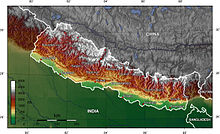
Nepal is of roughly trapezoidal shape, about 800 kilometres (500 mi) long and 200 kilometres (120 mi) wide, with an area of 147,516 km2 (56,956 sq mi). It lies between latitudes 26° and 31°N, and longitudes 80° and 89°E. Nepal's defining geological processes began 75 million years ago when the Indian plate, then part of the southern supercontinent Gondwana, began a north-eastward drift caused by seafloor spreading to its south-west, and later, south and south-east.[75] Simultaneously, the vast Tethyn oceanic crust, to its northeast, began to subduct under the Eurasian plate.[75] These dual processes, driven by convection in the Earth's mantle, both created the Indian Ocean and caused the Indian continental crust eventually to under-thrust Eurasia and to uplift the Himalayas.[75] The rising barriers blocked the paths of rivers creating large lakes, which only broke through as late as 100,000 years ago, creating fertile valleys in the middle hills like the Kathmandu Valley. In the western region, rivers which were too strong to be hampered, cut some of the world's deepest gorges.[76] Immediately south of the emerging Himalayas, plate movement created a vast trough that rapidly filled with river-borne sediment[77] and now constitutes the Indo-Gangetic Plain.[78] Nepal lies almost completely within this collision zone, occupying the central sector of the Himalayan arc, nearly one-third of the 2,400 km (1,500 mi)-long Himalayas,[79][80][81][82][83][84] with a small strip of southernmost Nepal stretching into the Indo-Gangetic plain and two districts in the northwest stretching up to the Tibetan plateau.[76]
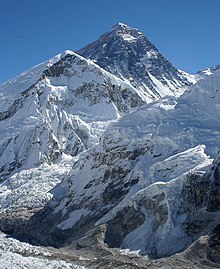
Nepal is divided into three principal physiographic belts known as Himal–Pahad–Terai.[g] Himal is the mountain region containing snow and situated in the Great Himalayan Range; it makes up the northern part of Nepal. It contains the highest elevations in the world including 8,848.86 metres (29,032 ft) height Mount Everest (Sagarmāthā in Nepali) on the border with China. Seven other of the world's "eight-thousanders" are in Nepal or on its border with Tibet: Lhotse, Makalu, Cho Oyu, Kangchenjunga, Dhaulagiri, Annapurna and Manaslu. Pahad is the mountain region that does not generally contain snow. The mountains vary from 800 to 4,000 metres (2,600 to 13,100 ft) in altitude, with progression from subtropical climates below 1,200 metres (3,900 ft) to alpine climates above 3,600 metres (11,800 ft). The Lower Himalayan Range, reaching 1,500 to 3,000 metres (4,900 to 9,800 ft), is the southern limit of this region, with subtropical river valleys and "hills" alternating to the north of this range. Population density is high in valleys but notably less above 2,000 metres (6,600 ft) and very low above 2,500 metres (8,200 ft), where snow occasionally falls in winter. The southern lowland plains or Terai bordering India are part of the northern rim of the Indo-Gangetic Plain. Terai is the lowland region containing some hill ranges. The plains were formed and are fed by three major Himalayan rivers: the Koshi, the Narayani, and the Karnali as well as smaller rivers rising below the permanent snowline. This region has a subtropical to tropical climate. The outermost range of the foothills called Sivalik Hills or Churia Range, cresting at 700 to 1,000 metres (2,300 to 3,280 ft), marks the limits of the Gangetic Plain. Broad, low valleys called Inner Terai Valleys (Bhitri Tarai Upatyaka) lie north of these foothills in several places.

The Indian plate continues to move north relative to Asia at about 50 mm (2.0 in) per year.[85] This makes Nepal an earthquake-prone zone, and periodic earthquakes that have devastating consequences present a significant hurdle to development.[86] Erosion of the Himalayas is a very important source of sediment, which flows to the Indian Ocean.[87] Saptakoshi, in particular, carries a huge amount of silt out of Nepal but sees extreme drop in Gradient in Bihar, causing severe floods and course changes, and is, therefore, known as the sorrow of Bihar. Severe flooding and landslides cause deaths and disease, destroy farmlands and cripple the transport infrastructure of the country, during the monsoon season each year.
Nepal has five climatic zones, broadly corresponding to the altitudes. The tropical and subtropical zones lie below 1,200 metres (3,900 ft), the temperate zone 1,200 to 2,400 metres (3,900 to 7,900 ft), the cold zone 2,400 to 3,600 metres (7,900 to 11,800 ft), the subarctic zone 3,600 to 4,400 metres (11,800 to 14,400 ft), and the Arctic zone above 4,400 metres (14,400 ft). Nepal experiences five seasons: summer, monsoon, autumn, winter and spring. The Himalayas block cold winds from Central Asia in the winter and form the northern limits of the monsoon wind patterns.
Biodiversity
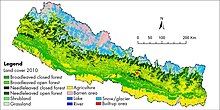
Nepal contains a disproportionately large diversity of plants and animals, relative to its size.[89][90] Nepal, in its entirety, forms the western portion of the eastern Himalayan biodiversity hotspot, with notable biocultural diversity.[91] The dramatic differences in elevation found in Nepal (60 m from sea level in the Terai plains, to 8,848 m Mount Everest)[92] result in a variety of biomes.[89] The Eastern half of Nepal is richer in biodiversity as it receives more rain, compared to western parts, where arctic desert-type conditions are more common at higher elevations.[90] Nepal is a habitat for 4.0% of all mammal species, 8.9% of bird species, 1.0% of reptile species, 2.5% of amphibian species, 1.9% of fish species, 3.7% of butterfly species, 0.5% of moth species and 0.4% of spider species.[90] In its 35 forest-types and 118 ecosystems,[89][h] Nepal harbours 2% of the flowering plant species, 3% of pteridophytes and 6% of bryophytes.[90]

Nepal's forest cover is 59,624 km2 (23,021 sq mi), 40.36% of the country's total land area, with an additional 4.38% of scrubland, for a total forested area of 44.74%, an increase of 5% since the turn of the millennium.[93] The country had a 2019 Forest Landscape Integrity Index mean score of 7.23/10, ranking it 45th globally out of 172 countries.[94] In the southern plains, Terai–Duar savanna and grasslands ecoregion contains some of the world's tallest grasses as well as Sal forests, tropical evergreen forests and tropical riverine deciduous forests.[95] In the lower hills (700 m – 2,000 m), subtropical and temperate deciduous mixed forests containing mostly Sal (in the lower altitudes), Chilaune and Katus, as well as subtropical pine forest dominated by chir pine are common. The middle hills (2,000 m – 3,000 m) are dominated by oak and rhododendron. Subalpine coniferous forests cover the 3,000 m to 3,500 m range, dominated by oak (particularly in the west), Eastern Himalayan fir, Himalayan pine and Himalayan hemlock; rhododendron is common as well. Above 3,500 m in the west and 4,000 m in the east, coniferous trees give way to rhododendron-dominated alpine shrubs and meadows.[90]
Among the notable trees, are the astringent Azadirachta indica, or neem, which is widely used in traditional herbal medicine,[96] and the luxuriant Ficus religiosa, or peepal,[97] which is displayed on the ancient seals of Mohenjo-daro,[98] and under which Gautam Buddha is recorded in the Pali canon to have sought enlightenment.[99]
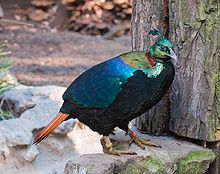
Most of the subtropical evergreen broad-leaved forest of the lower Himalayan region is descended from the Tethyan Tertiary flora.[101] As the Indian Plate collided with Eurasia forming and raising the Himalayas, the arid and semi-arid Mediterranean flora was pushed up and adapted to the more alpine climate over the next 40–50 million years.[101][102] The Himalayan biodiversity hotspot was the site of mass exchange and intermingling of the Indian and Eurasian species in the neogene.[103] One mammal species (Himalayan field mouse), two each of bird and reptile species, nine amphibia, eight fish and 29 butterfly species are endemic to Nepal.[90][i]
Nepal contains 107 IUCN-designated threatened species, 88 of them animal species, 18 plant species and one species of "fungi or protist" group.[105] These include the endangered Bengal tiger, the red panda, the Asiatic elephant, the Himalayan musk deer, the wild water buffalo and the South Asian river dolphin,[106] as well as the critically endangered gharial, the Bengal florican,[89][107] and the white-rumped vulture, which has become nearly extinct by having ingested the carrion of diclofenac-treated cattle.[108] The pervasive and ecologically devastating human encroachment of recent decades has critically endangered Nepali wildlife. In response, the system of national parks and protected areas, first established in 1973 with the enactment of National Parks and Wildlife Conservation Act 1973,[109] was substantially expanded. Vulture restaurants[90] coupled with a ban on veterinary usage of diclofenac has seen a rise in the number of white-rumped vultures.[110][108] The community forestry programme which has seen a third of the country's population directly participate in managing a quarter of the total forested area has helped the local economies while reducing human-wildlife conflict.[111][112] The breeding programmes[113] coupled with community-assisted military patrols,[114] and a crackdown on poaching and smuggling, has seen poaching of critically endangered tigers and elephants as well as vulnerable rhinos, among others, go down to effectively zero, and their numbers have steadily increased.[115] Nepal has ten national parks, three wildlife reserves, one hunting reserve, three Conservation Areas and eleven buffer zones, covering a total area of 28,959.67 km2 (11,181.39 sq mi), or 19.67% of the total land area,[116] while ten wetlands are registered under the Ramsar Convention.[117]
Politics and government
Politics
 |
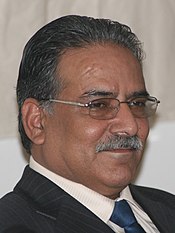
|
| Ram Chandra Poudel President |
Pushpa Kamal Dahal Prime Minister |
Nepal is a parliamentary republic with a multi-party system.[118] Nepal used to be referred as the 'Federal Democratic Republic of Nepal' until the Nepal Government decided to use just 'Nepal' as official name of the country.[119] It has seven national political parties recognised in the federal parliament: Communist Party of Nepal (Unified Marxist–Leninist), Nepali Congress, Communist Party of Nepal (Maoist Centre), Rastriya Swatantra Party, Rastriya Prajatantra Party, People's Socialist Party and Janamat Party.[120][118] Of the two major parties which both officially espouse democratic socialism, CPN(UML) is considered leftist while Nepali Congress is considered centrist.[121] During most of the brief periods of democratic exercise in the 1950s and the 1990s, Nepali Congress held majority of seats in parliament; CPN (UML) was its competitor in the 1990s.[122] After the Maoists entered the political process in 2006, they emerged as the third largest party.[69] In the aftermath of the 2017 elections, the first one according to the new constitution, NCP, formed by the merger of CPN (UML) and CPN (Maoist Centre) had become the ruling party at the federal level and in six out of seven provinces.[123] After the 2022 general election, the House of Representatives of 2nd Federal parliament was formed as hung parliament and a coalition government led by Pushpa Kamal Dahal was formed in December 2022.[124]
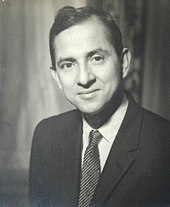
In the 1930s, a vibrant underground political movement arose in the capital, birthing Nepal Praja Parishad in 1936,[62] which was dissolved seven years later, following the execution of the four great martyrs. Around the same time, Nepalis involved in the Indian independence movement started organizing into political parties, leading to the birth of Nepali Congress and Communist Party of Nepal.[125] As communism was trying to find its footing, Nepali Congress was successful in overthrowing the Rana regime in 1951 and enjoyed the overwhelming support of the electorate.[126] In the partyless Panchayat system initiated in 1962 by King Mahendra, monarchy loyalists took turns leading the government; political leaders remained underground, exiled or in prison.[62] A communist insurgency was crushed in its cradle in the 1970s, which led to the eventual coalescence of hitherto scattered communist factions under the United Left Front.
After the joint civil resistance launched by the United Left Front and Nepali Congress overthrew the Panchayat in 1990,[126][127] the Front became CPN (UML), adopted multi-party democracy, and in the brief period, it was in government, introduced welfare programmes that remain popular.[122] After the Maoist Party joined mainstream politics, in the aftermath of the peaceful revolution of 2006, it also adopted multi-party democracy as its official line. The transition period between 2006 and 2015 saw sustained protests from the newly formed ethnocentric nationalist movements, principal among them the Madhes Movement.
Government
Nepal is governed according to the Constitution of Nepal. It defines Nepal as having multi-ethnic, multi-lingual, multi-religious, multi-cultural characteristics with common aspirations of people living in diverse geographical regions, and being committed to and united by a bond of allegiance to the national independence, territorial integrity, national interest, and prosperity of Nepal.[3]
The Government of Nepal has three branches:[3]
- Executive: The form of governance is a multi-party, competitive, federal democratic republican parliamentary system based on plurality. The President appoints the parliamentary party leader of the political party with the majority in the House of Representatives as Prime Minister, who forms the Council of ministers that exercises the executive power.
- Legislature: The Legislature of Nepal, called the Federal Parliament, consists of the House of Representatives and the National Assembly. The House of Representatives consists of 275 members elected through a mixed electoral system and has a term of five years. The National Assembly, consisting of 59 members elected by provincial electoral colleges, is a permanent house; a third of its members are elected every two years for a six-year term.[128]
- Judiciary: Nepal has a unitary three-tier independent judiciary that comprises the Supreme Court, the highest court in the land, headed by the Chief Justice, seven High Courts, one in each province, the highest court at the provincial level, and 77 district courts, one in each district. The municipal councils can convene local judicial bodies to resolve disputes and render non-binding verdicts in cases not involving actionable crime. The actions and proceedings of the local judicial bodies may be guided and countermanded by the district courts.[3]
Administrative divisions
| Province | Capital | Governor | Chief Minister | Districts | Area (km2) |
Population Census 2011 |
Population Census 2021 |
Density (people/km2) 2021 |
Human Development Index |
Map |
|---|---|---|---|---|---|---|---|---|---|---|
| Koshi Province | Biratnagar | Somnath Adhikari | Hikmat Kumar Karki | 14 | 25,905 | 4,534,943 | 4,972,021 | 192 | 0.553 | 
|
| Madhesh Province | Janakpur | Hari Shankar Mishra | Saroj Yadav | 8 | 9,661 | 5,404,145 | 6,126,288 | 634 | 0.485 | 
|
| Bagmati Province | Hetauda | Yadav Chandra Sharma | Salikram Jamkattel | 13 | 20,300 | 5,529,452 | 6,084,042 | 300 | 0.560 | 
|
| Gandaki Province | Pokhara | Prithvi Man Gurung | Khagaraj Adhikari | 11 | 21,856 | 2,403,757 | 2,479,745 | 113 | 0.567 | 
|
| Lumbini Province | Deukhuri | Amik Sherchan | Leela GIri | 12 | 19,707 | 4,499,272 | 5,124,225 | 260 | 0.519 | 
|
| Karnali Province | Birendranagar | Govinda Prasad Kalauni | Raj Kumar Sharma | 10 | 30,213 | 1,570,418 | 1,694,889 | 56 | 0.469 | 
|
| Sudurpashchim Province | Godawari | Ganga Prasad Yadav | Rajendra Singh Rawal | 9 | 19,539 | 2,552,517 | 2,711,270 | 139 | 0.478 | 
|
| Nepal | Kathmandu | President Ram Chandra Poudel |
Prime Minister Pushpa Kamal Dahal |
77 | 147,181 | 26,494,504 | 29,192,480 | 198 | 0.579 | 
|
Nepal is a federal republic comprising 7 provinces. Each province is composed of 8 to 14 districts. The districts, in turn, comprise local units known as urban and rural municipalities.[3] There is a total of 753 local units which includes 6 metropolitan municipalities, 11 sub-metropolitan municipalities and 276 municipalities for a total of 293 urban municipalities, and 460 rural municipalities.[129] Each local unit is composed of wards. There are 6,743 wards in total.
The local governments enjoy executive and legislative as well as limited judicial powers in their local jurisdiction. The provinces have unicameral parliamentary Westminster system of governance. The local and provincial governments exercise some absolute powers and some powers shared with provincial or federal government. The district coordination committee, a committee composed of all elected officials from the local governments in the district, has a very limited role.[3][129]
Laws and law enforcement

The Constitution of Nepal is the supreme law of the land, and any other laws contradicting it are automatically invalid to the extent of the contradiction.[130] The specific legal provisions are codified as Civil Code and Criminal Code, accompanied by Civil Procedure Code and Criminal Procedure Code respectively.[131] The Supreme Court is the highest authority in the interpretation of laws and it can direct the parliament to amend or enact new laws as required. Nepali laws are considered generally more progressive compared to other developing countries, and in some instances, many developed ones. The death penalty has been abolished.[132] Nepal also has made progress in LGBT rights and gender equality. It recognises marital rape and supports abortion rights. Owing to a rise in sex-selective abortion, however, constraints have been introduced. Nepal is a signatory to the Geneva Convention, Conventions/Treaties on the prohibition of Biological, Chemical and Nuclear weapons,[133] International Labour Organization Fundamental Conventions, Treaty on the Non-Proliferation of Nuclear Weapons and the Paris climate accord. Some legal provisions, guided by socio-economic, cultural and religious sensibilities, remain discriminatory. There is gender-based discrimination against foreign nationals married to Nepali citizens.[j] Paternal lineage of a person is valued and required in legal documents. Many laws remain unenforced in practice.
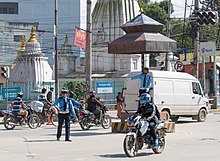
Nepal Police is the primary law enforcement agency. It is an independent organisation under the command of the Inspector General, who is appointed by and reports to the Ministry of Home Affairs. In addition to maintaining law and order, it is responsible for the management of road traffic, which is undertaken by Nepal Traffic Police. Nepal Armed Police Force, a separate paramilitary police organisation, works in cooperation with Nepal police in routine security matters; it is intended for crowd control, counter-insurgency and anti-terrorism actions, and other internal matters where the use of force may be necessary. The Crime Investigation Department of Nepal Police specialises in criminal investigation and forensic analysis.[135][136][137][138][139] The Commission for the Investigation of Abuse of Authority is an independent investigative agency that investigates and prosecutes cases related to corruption, bribery and abuses of authority. At 2.16 per 100,000 in 2016, Nepal's intentional homicide rate is much lower than average; police data indicates a steady increase in the crime rate in recent years.[140] Nepal was ranked 76 out of 163 countries in the Global Peace Index (GPI) in 2019.[141]
Foreign relations

Nepal depends on diplomacy for national defence. It maintains a policy of neutrality between its neighbours, has amicable relations with other countries in the region, and has a policy of non-alignment at the global stage. Nepal is a member of SAARC, UN, WTO, BIMSTEC and ACD, among others. It has bilateral diplomatic relations with 167 countries and the EU,[142] has embassies in 30 countries[143] and six consulates,[144] while 25 countries maintain embassies in Nepal, and more than 80 others maintain non-residential diplomatic missions.[145] Nepal is one of the major contributors to the UN peacekeeping missions, having contributed more than 119,000 personnel to 42 missions since 1958.[146] Nepali people have a reputation for honesty, loyalty and bravery, which has led to them serving as legendary Gurkha warriors in the Indian and British armies for the last 200 years, with service in both world wars, India-Pakistan wars as well as Afghanistan and Iraq,[147] though Nepal was not directly involved in any of those conflicts, and winning the highest military awards, including the Victoria Cross and the Param Vir Chakra.[148]

Nepal pursues a policy of "balanced relations" with the two giant immediate neighbours, India and China;[149][150] the 1950 Treaty of Peace and Friendship with India provides for a much closer relationship.[151] Nepal and India share an open border with free movement of people, religious, cultural and marital ties. India is Nepal's largest trading partner, which it depends upon for all of its oil and gas, and a number of essential goods. Nepalis can own property in India, while Indians are free to live and work in Nepal.[152] Relations between India and Nepal, though very close, have faced difficulties stemming from territorial disputes,[153] economics, and the problems inherent in big power-small power relations.[154][failed verification] Nepal established diplomatic relations with the People's Republic of China on 1 August 1955, and signed the Treaty of Peace and Friendship in 1960; relations since have been based on the Five Principles of Peaceful Coexistence. Nepal maintains neutrality in conflicts between China and India. It remains firmly committed to the One China Policy and is known to curb anti-China activities from the Tibetan refugees in Nepal.[155][156] Citizens of both countries can cross the border and travel as far as 30 km without a visa.[157] China is viewed favourably in Nepal owing to the absence of any border disputes or serious interference in internal politics, coupled with its assistance in infrastructure development and aid during emergencies; favourability has increased since China helped Nepal during the 2015 economic blockade imposed by India.[158] Subsequently, China granted Nepal access to its ports for third-country trade, and Nepal joined China's Belt and Road Initiative.[159]
Nepal emphasises greater cooperation in South Asia and actively pushed for the establishment of SAARC, the South Asian Association for Regional Cooperation, the permanent secretariat of which, is hosted in Kathmandu.[160] Nepal was one of the first countries to recognise an independent Bangladesh, and the two countries seek to enhance greater cooperation, on trade and water management; seaports in Bangladesh, being closer, are seen as viable alternatives to India's monopoly on Nepal's third-country trade.[161] Nepal was the first South Asian country to establish diplomatic relations with Israel, and the countries enjoy a strong relationship;[162] it recognises the rights of the Palestinians, having voted in favour of its recognition at the UN and against the recognition of Jerusalem as Israel's capital.[163] Countries that Nepal maintains a close relationship with, include the most generous donors and development partners—the United States, the United Kingdom, Denmark, Japan and Norway, among others.[164]
Military and intelligence

The President is the supreme commander of the Nepali Army; its routine management is handled by the Ministry of Defence. The military expenditure for 2018 was $398.5 million,[165] around 1.4% of GDP.[166] An almost exclusively ground infantry force, Nepal Army numbers at less than one hundred thousand;[167][168][169] recruitment is voluntary.[170] It has few aircraft, mainly helicopters, primarily used for transport, patrol, and search and rescue.[171] Directorate of Military Intelligence under Nepal Army serves as the military intelligence agency;[172] National Investigation Department tasked with national and international intelligence gathering, is independent.[167] Nepal Army is primarily used for routine security of critical assets, an anti-poaching patrol of national parks, counterinsurgency, and search and rescue during natural disasters;[173] it also undertakes major construction projects.[174] There are no discriminatory policies on recruitment into the army, but it is dominated by men from elite Pahari warrior castes.[175][176]
Economy
Nepal is a developing country, which ranks 165th in the world[k] in nominal GDP per capita[177] and 162nd[l] in GDP per capita at PPP.[178] Nepal's gross domestic product (GDP) for 2019 was $34.186 billion.[179][180] With an annual growth rate calculated at 6.6% in 2019,[181] and expected 2.89% in 2021,[182] Nepal is one of the fastest-growing economies in the world.[citation needed] Nepal has been a member of WTO since 23 April 2004.[183]
The 16.8-million-worker Nepali labour force is the 37th largest in the world.[184] The primary sector makes up 27.59% of GDP, the secondary sector 14.6%, and the tertiary sector 57.81%.[185] Nepal's foreign exchange remittances of US$8.1 billion in 2018, the 19th largest in the world and constituting 28.0% of GDP,[186] were contributed to its economy by millions of workers primarily in India, the Middle East and East Asia, almost all of them unskilled labourers.[187][188] Major agricultural products include cereals (barley, maize, millet, paddy and wheat), oilseed, potato, pulses, sugarcane, jute, tobacco, milk and water buffalo meat.[189][190] Major industries include tourism, carpets, textiles, cigarettes, cement, brick, as well as small rice, jute, sugar and oilseed mills.[189] Nepal's international trade greatly expanded in 1951 with the establishment of democracy; liberalisation began in 1985 and picked up pace after 1990. By the fiscal year 2016/17, Nepal's foreign trade amounted Rs 1.06 trillion, a twenty-three folds increase from Rs 45.6 billion in 1990/91. More than 60% of Nepal's trade is with India. Major exports include readymade garment, carpet, pulses, handicrafts, leather, medicinal herbs, and paper products, which account for 90% of the total. Major imports include various finished and semi-finished goods, raw materials, machinery and equipment, chemical fertilisers, electrical and electronic devices, petroleum products, gold, and readymade garments.[191] Inflation was at 4.5% in 2019.[192] Foreign exchange reserves were at US$9.5 billion in July 2019, equivalent to 7.8 months of imports.[192]
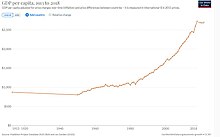
Nepal has made significant progress in poverty reduction bringing the population below the international poverty line (US$1.90 per person per day) from 15% in 2010 to just 9.3% in 2018, although vulnerability remains extremely high, with almost 32% of the population living on between US$1.90 and US$3.20 per person per day.[192] Nepal has made improvement in sectors like nutrition, child mortality, electricity, improved flooring and assets. Under the current trend, Nepal is expected to eradicate poverty within 20 years.[193][194] The agriculture sector is particularly vulnerable as it is highly dependent on the monsoon rains, with just 28% of the arable land being irrigated, As of 2014[update].[195] Agriculture employs 76% of the workforce, services 18%, and manufacturing and craft-based industry 6%.[196] Private investment, consumption, tourism and agriculture are the principal contributors to economic growth.[192]
The government's budget is about $13.71 billion (FY 2019/20);[197] expenditure of infrastructure development budget, most of it contributed by foreign aid, usually fails to meet the target.[198] The country receives foreign aid from the UK,[199][200] India, Japan, the US, the EU, China, Switzerland, and Scandinavian countries. The Nepali rupee has been tied to the Indian rupee at an exchange rate of 1.6 for many years. Per capita income is $1,004.[201] The distribution of wealth among the Nepalis is consistent with that in many developed and developing countries: the highest 10% of households control 39.1% of the national wealth and the lowest 10% control only 2.6%. European Union (EU) (46.13%), the US (17.4%), and Germany (7.1%) are its main export partners; they mainly buy Nepali ready-made garments (RMG).[202] Nepal's import partners include India (47.5%), the United Arab Emirates (11.2%), China (10.7%), Saudi Arabia (4.9%), and Singapore (4%).
Besides having landlocked, rugged geography, few tangible natural resources and poor infrastructure, the ineffective post-1950 government and the long-running civil war are also factors in stunting the country's economic growth and development.[203][204][205] Debt bondage even involving debtors' children has been a persistent social problem in the western hills and the Terai, with an estimated 234,600 people or 0.82% of the population considered as enslaved, by The Global Slavery Index in 2016.[206]
In 2022, Nepal limited import of non-essential goods after its foreign currency reserves dropped. COVID-19 pandemic caused a decline in tourism spending and the money sent home by Nepalis working abroad, which in turn lowered country's foreign currency reserve.[207]
Tourism
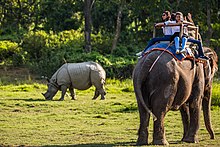
Tourism is one of the largest and fastest-growing industries in Nepal, employing more than a million people and contributing 7.9% of the total GDP.[208] The number of international visitors crossed one million in 2018 for the first time (not counting Indian tourists arriving by land).[208][209] Nepal's share of visitors to South Asia is about 6%, and they spend much less on average, with Nepal sharing 1.7% of the earnings.[210] Premier destinations include Pokhara, the Annapurna trekking circuit and the four UNESCO world heritage sites—Lumbini, Sagarmatha National Park (home to Mount Everest), seven sites in the Kathmandu Valley collectively listed as one, and Chitwan National Park. Most of Nepal's mountaineering earning comes from Mount Everest, which is more accessible from the Nepalese side.[citation needed]
Nepal, officially opened to westerners in 1951, became a popular destination at the end of the hippie trail, during the 1960s and 1970s. The industry, disrupted by the civil war in the 1990s, has since recovered but faces challenges to growth, owing to a lack of proper facilities for high-end tourism termed the "infrastructure bottleneck", mounting issues facing Nepal Airlines, and a handful of destinations properly developed and marketed.[citation needed] The home-stay tourism, in which cultural and eco-tourists stay as paying guests in the homes of indigenous people, has seen some success.[211]
Foreign employment

The rate of unemployment and underemployment exceeds half of the working-age population,[212] driving millions to seek employment abroad, mainly in India, the Gulf, and East Asia. Mostly unskilled, uneducated, and indebted to loan sharks, these workers are swindled by the manpower companies and sent to exploitative employers or war-ridden countries under fraudulent contracts.[213][214] They have their passports seized, to be returned when the employer grants them leave or terminates their contracts. Most do not get paid minimum wage,[215] and many are forced to forfeit all or part of the wages.[216] Many Nepalis work in extremely unsafe conditions; an average of two workers die each day.[217] Due to restrictions placed on women, many depend on traffickers to get out of the country, and end up victims of violence and abuse.[218] Many Nepalese are believed to be working under slavery-like conditions, and Nepal spends billions of rupees rescuing stranded workers, on remuneration to the indebted families of the dead, and in legal costs for those arrested in foreign countries.[219][220] Though millions have raised themselves out of poverty, due to a lack of entrepreneurial skills, the remittance is largely spent on real estate and consumption.[221][220]
Infrastructure
Energy
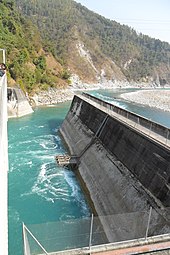
The bulk of energy in Nepal comes from biomass (80%) and imported fossil fuels (16%).[222] Most of the final energy consumption goes to the residential sector (84%) followed by transport (7%) and industry (6%); the transport and industry sectors have been expanding rapidly in recent years.[222] Except for some lignite deposits, Nepal has no known oil, gas or coal deposits.[222] All commercial fossil fuels (mainly oil, LPG and coal) are imported, spending 129% of the country's total export revenue.[223] Only about 1% of the energy need is fulfilled by electricity.[222] The perennial nature of Nepali rivers and the steep gradient of the country's topography provide ideal conditions for the development of hydroelectric projects. Estimates put Nepal's economically feasible hydro-power potential at approximately 42,000 MW.[222] Nepal has been able to exploit only about 1,100 MW. As most of it is generated from run-of-river (ROR) plants, the actual power produced is much lower in the dry winter months when peak demand can reach as high as 1,200 MW, and Nepal needs to import as much as 650 MW from India to meet the demands.[224] Major hydro-power projects suffer delays and setbacks.[225][226][227] Nepal's electrification rate (76%) is comparable to that of other countries in the region but there is significant disparity between the rural (72%) and urban (97%) areas.[222] The position of the power sector remains unsatisfactory because of high tariffs, high system losses, high generation costs, high overheads, over staffing, and lower domestic demand.[228]
Transportation
Nepal remains isolated from the world's major land, air and sea transport routes, although, within the country, aviation is in a better state, with 47 airports, 11 of them with paved runways;[229] flights are frequent and support a sizeable traffic. The hilly and mountainous terrain in the northern two-thirds of the country has made the building of roads and other infrastructure difficult and expensive. As of 2016[update], there were just over 11,890 km (7,388 mi) of paved roads, 16,100 km (10,004 mi) of unpaved roads, and just 59 km (37 mi) of railway line in the south.[229] As of 2018[update], all district headquarters (except Simikot) had been connected to the road network.[174] Most of the rural roads are not operable during the rainy season; even national highways regularly become inoperable.[230] Nepal depends almost entirely on assistance from countries like China, India and Japan, for building, maintenance and expansion of the road network. The only practical seaport of entry for goods bound for Kathmandu is Kolkata in India. The national carrier, Nepal Airlines, is in poor shape due to mismanagement and corruption, and has been blacklisted by the EU.[231] Internally, the poor state of development of the road system makes access to markets, schools, and health clinics a challenge.[203]
Communication
According to the Nepal Telecommunication Authority MIS August 2019 report, voice telephony subscription rate was at 2.70% of total population for fixed phones and 138.59% for mobile; 98% of all voice telephony was through mobile phones.[232] Similarly, while an estimated 14.52% had access to fixed broadband, an additional 52.71% were accessing the internet using their mobile data subscriptions; almost 15 million of them with 3G or better.[232] The mobile voice telephony and broadband market was dominated by two telecommunications companies, the state-owned Nepal Telecom (55%) and the private multinational, Ncell (40%).[232] Of the 21% market share enjoyed by fixed broadband, around 25% was again shared by Nepal Telecom, with the rest going to the private Internet Service Providers.[232] Although there is high disparity in penetration rate between the rural and urban areas, mobile service has reached 75 districts of the country covering 90% of land area, and broadband access is expected to reach 90% of the population by 2020.[229]
Media
As of 2019[update], the state operates three television stations as well as national and regional radio stations. There are 117 private TV channels and 736 FM radio stations licensed for operation, at least 314 of them, community radio stations.[229] According to the 2011 census, the percentage of households possessing radio was 50.82%, television 36.45%, cable TV 19.33%, and computer 7.28%.[233] According to the Press Council Nepal classification, as of 2017[update] of the 833 publications producing original content, ten national dailies and weeklies are rated A+ class.[234] In 2019, Reporters Without Borders ranked Nepal at 106th in the world in terms of press freedom.[235]
Demographics
| Year | Pop. | ±% p.a. |
|---|---|---|
| 1911 | 5,638,749 | — |
| 1920 | 5,573,788 | −0.13% |
| 1930 | 5,532,574 | −0.07% |
| 1941 | 6,283,649 | +1.16% |
| 1952/54 | 8,256,625 | +2.51% |
| 1961 | 9,412,996 | +1.47% |
| 1971 | 11,555,983 | +2.07% |
| 1981 | 15,022,839 | +2.66% |
| 1991 | 18,491,097 | +2.10% |
| 2001 | 23,151,423 | +2.27% |
| 2011
Zdroj:https://en.wikipedia.org?pojem=Nepal Text je dostupný za podmienok Creative Commons Attribution/Share-Alike License 3.0 Unported; prípadne za ďalších podmienok. Podrobnejšie informácie nájdete na stránke Podmienky použitia.
Analytika
Antropológia Aplikované vedy Bibliometria Dejiny vedy Encyklopédie Filozofia vedy Forenzné vedy Humanitné vedy Knižničná veda Kryogenika Kryptológia Kulturológia Literárna veda Medzidisciplinárne oblasti Metódy kvantitatívnej analýzy Metavedy Metodika Text je dostupný za podmienok Creative
Commons Attribution/Share-Alike License 3.0 Unported; prípadne za ďalších
podmienok. www.astronomia.sk | www.biologia.sk | www.botanika.sk | www.dejiny.sk | www.economy.sk | www.elektrotechnika.sk | www.estetika.sk | www.farmakologia.sk | www.filozofia.sk | Fyzika | www.futurologia.sk | www.genetika.sk | www.chemia.sk | www.lingvistika.sk | www.politologia.sk | www.psychologia.sk | www.sexuologia.sk | www.sociologia.sk | www.veda.sk I www.zoologia.sk |


